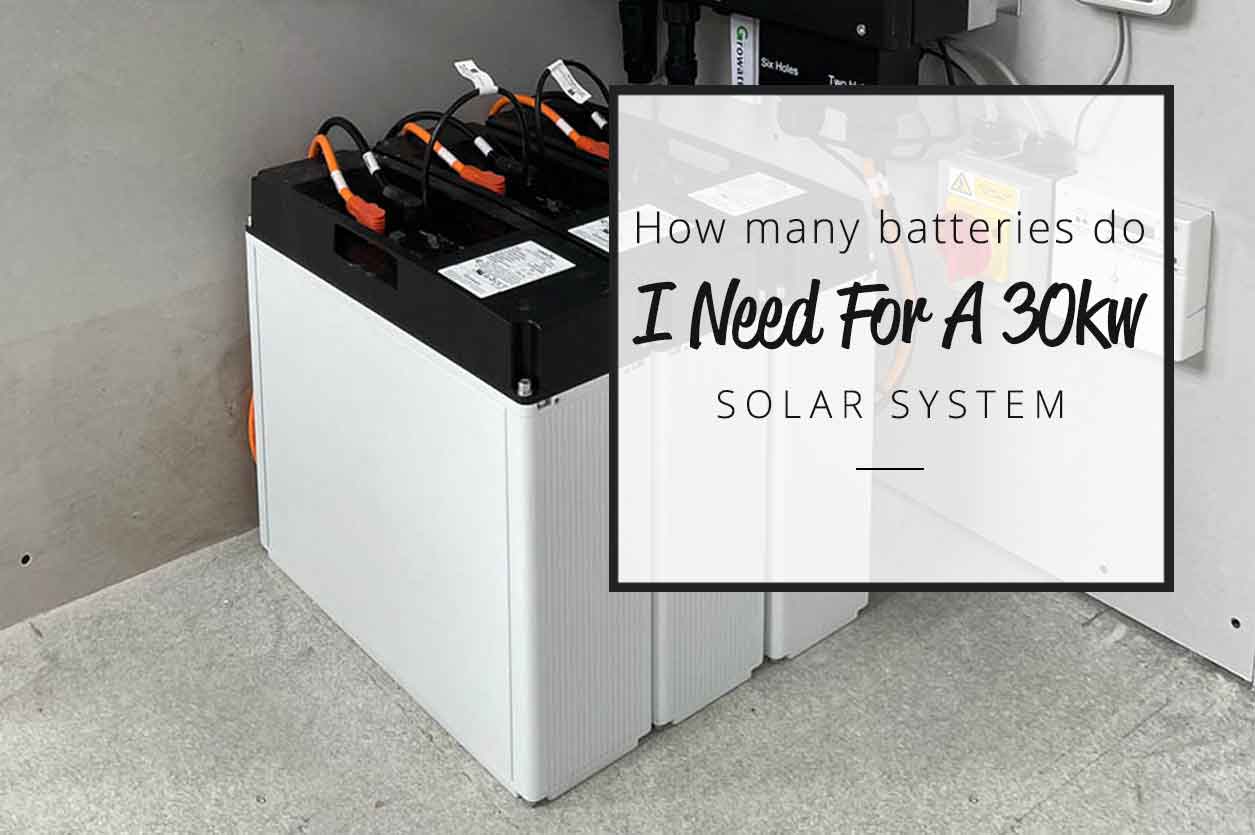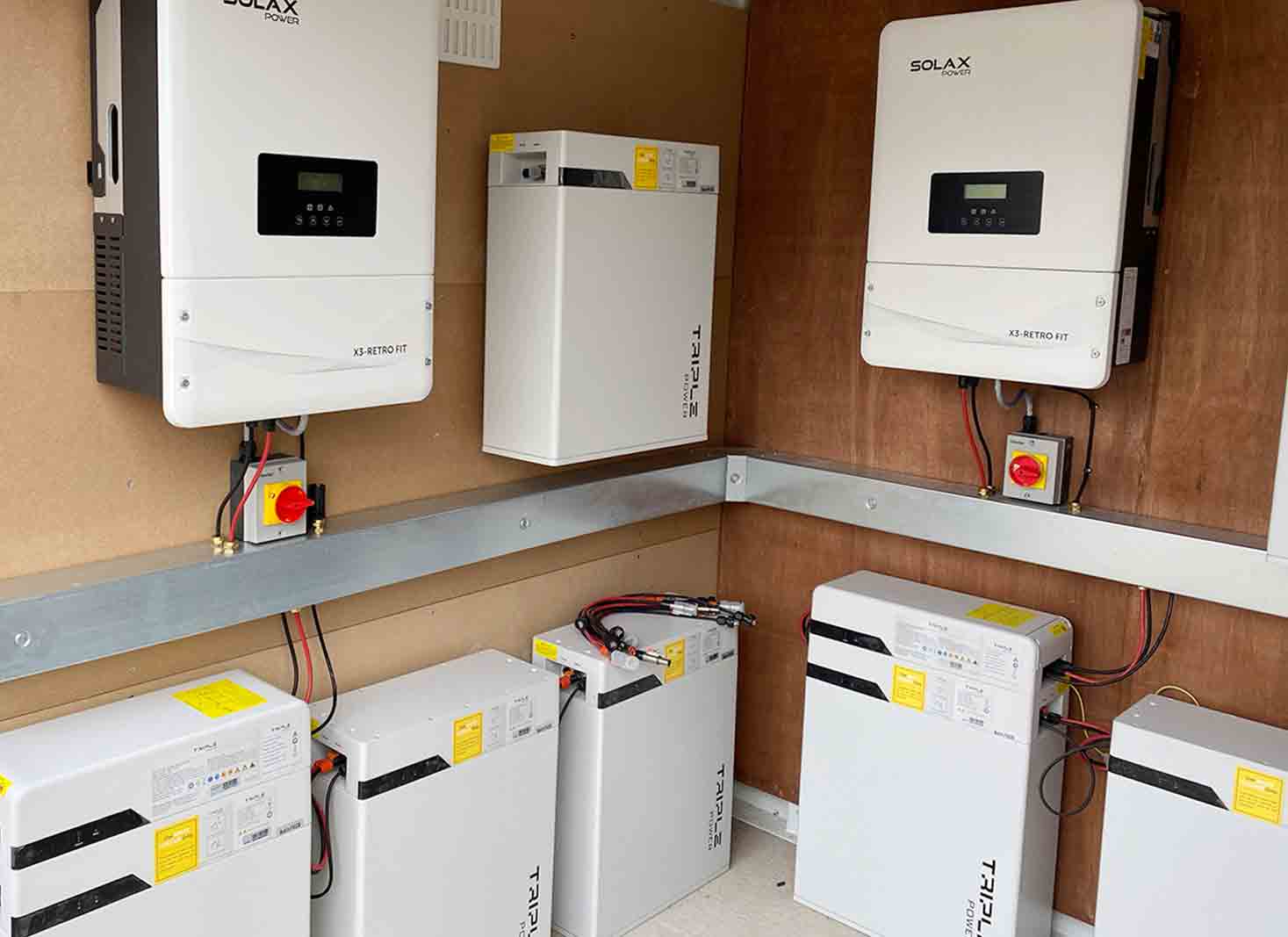Home Solar Battery Storage How Many Batteries Do I Need for a 30kw Solar System
How Many Batteries Do I Need for a 30 kW Solar System
A 30 kW solar system is an excellent choice for large homes and business operations. So, if your average daily energy use is anywhere from 80 to 120 kWh, the 30 kW system would suit your needs spot on.
Hence, if you already have the system or are planning to purchase it, you should consider investing in a good-quality battery system to get the maximum benefit from your panels. That said, you should know the right battery size for your 30 kW system before making any purchases.
Typically, a 30 kW solar system produces about 120 kWh of energy per day1. This means it will require a total battery capacity of at least 84 kWh for use at night. The Tesla PowerWall 2 has a storage capacity of 14 kWh2, so a 30 kW solar system will require at least six batteries to store sufficient energy.
In this article, you will learn how to calculate the right battery size for your solar system and how to choose the best battery type.

Table of Contents
ToggleHow to calculate the number of batteries needed for a 30kw solar system?
There are ways to calculate the estimated number of batteries needed for a particular solar system. This solar battery formula allows households to know how many batteries are required to store energy for nighttime when solar panels no longer work.
Here are the steps to calculate the number of batteries needed for a 30kw solar system;
1. Calculate the total energy consumption
The first step to determining the number of batteries needed by a 30 kW solar system is by calculating the total energy consumption covered by the solar system. This is obtained by the summation of all the wattage of electrical equipment in the house multiplied by the average number of hours used daily3.
To get the total energy consumption in kilowatt-hours = summation of (wattage of electrical appliance x avg. hours used)
You can also look at previous electrical bills as it is usually given by energy providers. Once you have gotten the daily energy consumed in that location, you can move on to step 2.
2. Calculate the battery size for the energy recorded
The second step to determining the number of batteries needed by a 30 kW solar system is to calculate the best battery size for the amount of energy consumed daily. For example, if the business uses an estimated 120 kWh of energy daily.
A 30 kWh solar system is perfect for this business as it produces an average of 120 kWh of electricity daily. This means that the solar system will meet the business’s energy needs. A good battery needs to store at least 70% of the total energy produced to be used at night4.
70 percent of 120 kWh is 84 kWh. This means that for a 30 kW solar system, the total battery capacity must be at least 84 kW. If you decide to purchase a battery with a 14 kW capacity, you will need (84/14 = 6 batteries) at least 6 14 kW solar batteries for a 30 kW solar system.
NOTE; It is important to note that the higher the battery capacity, the lower the number of batteries required. For example, a 30 kW solar system will need four, 25 kW batteries compared to the six, 14 kW batteries in the above case study.
How long will the batteries of a 30 kW solar system last?
Solar batteries used in any solar system such as a 30 kW solar system have an average life span of 5 to 15 years5. The exact lifespan of solar batteries is determined by many factors such as; the type of battery, the level of care and maintenance, etc.
The type of battery is one of the major factors that greatly affects the lifespan of a battery. We have three types of solar batteries; lithium batteries, lead acid batteries, and nickel-cadmium batteries. Lithium batteries have the longest lifespan at 10 to 15 years6 while lead acid batteries have the shortest at 5 to 7 years7.
A well-maintained solar battery will have a longer lifespan when compared with one that has not been well-maintained. This is because maintenance helps to remove any deterrents to the battery’s normal functioning. Maintenance is mostly done on Lead-acid batteries as they require regular cleaning of their terminals to remove any corrosion.
You can also extend the battery life of solar batteries by avoiding overcharging, service when necessary and always following instructions, etc.
What type of battery is best for a 30 kW solar system

We have three major types of solar batteries available on the market. However, only lithium batteries and lead-acid batteries are used in small-scale solar systems.
1. Lithium battery
Lithium batteries are generally the choice to go with when choosing solar batteries for a 30 kW solar system. They may be more expensive than lead acid batteries, however, they are smaller, last longer, and are more efficient.
Lithium batteries usually come with a 10-year warranty8, although they have an estimated lifespan of 15 years. They require little to no maintenance, making them a good choice for commercial settings.
2. Lead Acid Battery
Lead Acid batteries are the oldest technology in terms of solar batteries. It has been around for over a century and is known for its durability and accessibility. Lead Acid batteries are cheap, making them the choice for many households.
However, they do not last as long as lithium batteries and require regular maintenance9 which makes them a poor choice for businesses that may require constant electricity.
How many solar panels do I need for a 30 kW solar system?

The 30 kW solar system is massive in terms of the energy it produces. The solar system produces an estimated 120 kW of energy daily. It requires an average of 82 to 10010 solar panels in order to collect enough solar radiation to produce the maximum amount of electricity.
The actual number of solar panels required depends mainly on the wattage of the solar panel. The higher the wattage of a solar panel, the more electricity it produces. For example, you will need 80 375-watt solar panels compared to 100 300-watt solar panels as 375 watts is more efficient in producing electricity compared to the 300-watt solar panel10.
FAQ's
A 30kw solar system is quite big as it produces enough energy to power 3 houses with an average daily energy consumption of 40kWh. This is because the 30kw solar system produces about 120 kWh of electricity daily. The 30kw solar system is often used by small to medium-sized businesses or very large homes.
The 30kW Solar system is a fairly big generation unit, heavily suited towards commercial establishments; It can be suitable for residential clients as well provided you have roof space and consistently high power usage patterns. It requires copious amounts of space to be installed.
For instance, the average number of solar panels needed for a 30kw solar system ranges from 82 to 100, and the space required to install these solar panels is often not found in residential settings.
The 30kw solar system also requires a large number of batteries necessary to store 70% of its energy for nighttime. These batteries occupy a lot of space which again is not found in many residential houses. The amount of energy produced, number of solar panels required, number of batteries required, etc, all make the 30kw solar system conducive for commercial settings.
The 30kw solar system is a solar system targeted toward commercialized settings and enterprises. As discussed earlier, the solar system requires an immense amount of space not usually found in residential settings.
Generally, 30kW systems vary in price. The price depends mainly on the type of package requested, the number of solar rebates in your state, and many more. Here is a summarized table showing the cost of a 30kw solar system in major cities across Australia.
These prices are estimates and cannot be taken as an exact measure. Call a trusted solar provider company for a quote to get an actual price in our area.
| CITY | Price |
|---|---|
| Adelaide | $19,399 |
| Brisbane | $20,999 |
| Hobart | $23,699 |
| Melbourne | $21,799 |
| Perth | $19,399 |
| Sydney | $20,499 |
A 30kw solar system will offer real savings depending on how efficiently it is being used and how much of the energy produced is being properly utilized. The savings and payback on a solar system are based on the total amount generated which is then fed into the electricity grid.
This in turn gives solar panel owners the solar rebate known as the Feed-in Tariffs. Feed-in tariffs deal with the exporting of any excess unused Solar energy back to the power grid. It is an agreement between the Electricity Retailer and the solar panel owners. To ensure the best deal from the Electricity retailer, you can visit the recommended website www.energymadeeasy.gov.au
The above-mentioned website is a Federal initiative available to solar system owners. It allows solar system owners to view offers from various electricity retailers. This allows you to compare and contrast before choosing the best options from all available retailers.
- Tom Sedgwick, (2021), A case study: 30kW solar system on Stucco Housing Co-Op, Accessed on: 3rd March 2024, https://1komma5grad.com/au/blog/30kw-solar-system-case-study-stucco-housing-co-op
- Solar technologies, (2023), A comparison of Tesla’s powerwall 2 and powerwall plus: A guide for home owners. Accessed on: 3rd March 2024, https://solartechnologies.com/a-comparison-of-teslas-powerwall-2-and-powerwall-plus-a-guide-for-homeowners/#:~:text=The%20Powerwall%202%20has%20a,which%20simplifies%20the%20installation%20process.
- Uyen Nguyen , (2022), Five questions to understand the relationship between watt and kilowatt-hour,Energy price.be, Accessed on: 3rd March 2024, https://www.energyprice.be/blog/watt-and-kilowatt-hour/#:~:text=If%20you%20want%20to%20convert,divide%20the%20result%20by%201000.
- Solar Edge,(N.a),SolarEdge Home Battery FAQs, Accessed on: 3rd March 2024, https://knowledge-center.solaredge.com/sites/kc/files/solaredge-home-battery-faq-aus.pdf
- Akshay VR, (2022), How Long Do Rooftop Residential Solar Panels Last? Accessed on: 3rd March 2024,https://arka360.com/ros/how-long-rooftop-residential-solar-panels-last/CTRICITY
- Mia Johnson,(2023),Understanding the Lifespan of Lithium Batteries: How Long Do They Really Last? Accessed on: 3rd March 2024,https://theearthawards.org/how-long-do-lithium-batteries-last/#:~:text=and%20electric%20vehicles.-,Lithium%20Iron%20Phosphate%20(LiFePO4)%20Batteries,life%20to%2010%2D15%20years.
- Flux Power,( 2019), Lithium-ion vs Lead Acid Battery Life, Accessed on: 3rd March 2024, https://www.fluxpower.com/blog/lithium-ion-vs.-lead-acid-battery-life
- INVINITY Energy Systems, (N.a), Say Goodbye to Battery Warranty Anxiety: The Cycle Count & Throughput Advantages of Vanadium Flow Batteries, Accessed on: 3rd March 2024, https://invinity.com/battery-warranties/#:~:text=Depending%20on%20use%2C%20lithium%2Dion,end%20of%20their%20warranty%20period.
- Ajit Bahadur,(N.a),Difference Between Lithium-ion and Lead-acid Battery, Accessed on: 3rd March 2024, https://solarismypassion.com/solar-blogs/difference-between-lithium-ion-and-lead-acid-battery/
- Captain Solar Green. (N.a),30kw solar system Australia, Accessed on: 3rd March 2024, https://www.captaingreen.com.au/30kw-solar-system/#:~:text=The%2030kW%20solar%20system%20would,15kW%20or%20a%2027kW%20inverter.
Table of Contents
Toggle




